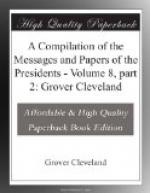It will therefore appear that if the profile of Messrs. Featherstonhaugh and Mudge be correct the lowest gap on the third part of the American line is about as high as the mean elevation of the part of the British line with which it is compared.
The line claimed by the United States therefore possesses throughout in a pre-eminent degree the highland character according to the sense at one time contended for in the argument of Great Britain, and is, to use the term of the British commissioners, “the axis of maximum elevation,” the mean of all the heights measured upon it being 1,459 feet, while that of those measured on the line of Messrs. Featherstonhaugh and Mudge is no more than 1,085 feet.
It is regretted that the computations of the barometric and other observations for the determination of the heights of that portion of the country between the valley of the St. John and the sources of the Aroostook, explored by the division of Major Graham, could not be completed in time to be made use of for this report in the description of that portion of the line claimed for Great Britain by Messrs. Featherstonhaugh and Mudge. This delay has been solely caused by a want of reasonable time to complete this portion of the work, the commissioner having direction of the division charged with it having only returned from the field in the month of January.
Sufficient information is known, however, to have been derived from those surveys to justify the assertion that, instead of the strongly marked range of highlands represented by the British commissioners as constituting a part of their “axis of maximum elevation,” the country in the vicinity of the Aroostook lying between its sources and the valley of the St. John is devoid of the character they have attributed to it. When properly represented upon a map it will appear as an extended undulating surface of moderate elevation above the level of the Aroostook River, sparsely interspersed with occasional detached elevations rising to heights of 600 to 900 and 1,400 feet above the level of the sea, but forming no continuous or connected chain whatever in the direction represented by the British commissioners, or that could be construed into the character of highlands such as are described in the treaty of 1783.[35]
[Footnote 35: Since the above was written Major Graham’s map and the computations of the barometric heights above alluded to have been completed.
This map exhibits in their proper positions the numerous altitudes which were determined throughout the country watered by the Aroostook and its principal tributaries, extending laterally to the heights which bound the basin of that river on either side; along the due west line traced in the year 1835 by Captain Yule, of the royal engineers, between Mars Hill and a point near the forks of the Great Machias River; along and in the vicinity of the road recently opened by the State of Maine from Lewis’s (a point in latitude 46 deg. 12’ 20”, between the head branches of the Meduxnikeag and the Masardis or St. Croix of the Aroostook) to the mouth of Fish River, in latitude 47 deg. 15’ 13”, being a distance, actually measured, of 79 miles; and along the new military road, embracing 40-1/2 miles of the distance from Fort Fairfield to Houlton and including the adjacent heights on either side.




